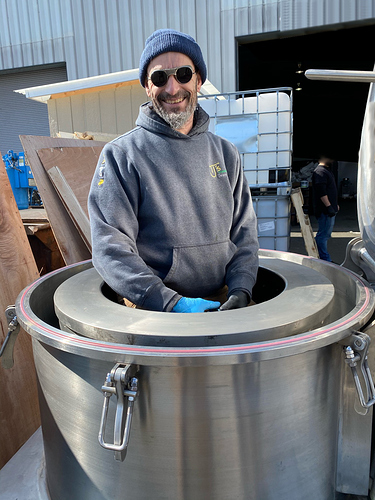That is a rather impressive facility, @RossK! You can definitely count on the advice from @Akoyeh & @cyclopath in general, and @thesk8nmidget has presented good information here, as well!
I will say that -40°C/F is a reasonable temperature for achieving decent selectivity with 190 proof potable ethanol. As long as your comminution (aka: milling, grinding, shredding, etc.) does NOT cut open too many plant cells, you actually maintain -40° at all times when plant matter (even sediment) is in contact with solvent, and you keep the solvent residence time on your biomass to a minimum (less than 15 minutes, total), your extracted tincture (ethanol:resin solution) should only require 3 or 4 stages of filtration to remove unwanted solids and solutes. While that temperature will exclude (from dissolution) all epicuticular wax and the vast majority of triglycerides (vegetable oil), there will be some free fatty acids (FFAs) and phosphatides (e.g. lecithin) that dissolve along with the resin, as well as chlorophyll and other pigments. The -67°C mentioned is the temperature at which chlorophyll, FFAs and phosphatides are almost completely excluded from solution, as well.
I will not reiterate what the others have said already regarding pre-chilling biomass, because their information is quite accurate. I will add that the condensed surface water that clings to cold biomass can also have the counterintuitive effect of warming your extraction solution! As @Akoyeh nearly mentioned when he wrote of heat capacity, water has a LOT more heat capacity than the dry cellulosic biomass! In other words, for every 1°C of temperature in every 1 gram of that superficial water mass (including all the water vapor from the air that condenses on the biomass as you move it from the freezer to the extraction chamber), the solid ice which must melt contains 2.1 joules & liquid water contains 4.2 joules of energy, while each gram of dry biomass has perhaps 1.5 to 1.8 joules per °C. Unlike water’s fairly constant heat capacity within its state, pure liquid ethanol’s heat capacity falls as it cools, and is less than 2J/g°C at -40°, although that is still higher than that of dry biomass, with at least 5% water in 190 proof, that water heat capacity exists in addition to the ethanol’s, keeping its total likely just above 2J/g°C.
Since it requires about 8 kg of -40° ethanol (-40° density is about 1.05X room temperature density) to cover every 1 kg of dry biomass, you can begin to see why it is only water’s high heat capacity that will be able to significantly impact the overall extraction temperature. Water will dissolve into ethanol almost instantly, distributing its heat energy much more quickly than solid biomass, and that excess water content, with its higher heat capacity, also makes it harder to cool the ethanol back down; not to mention the deleterious effect that excess water has upon the resin extraction efficiency of the solvent!
The short & sweet solution to heat capacity is thus; DRY your biomass as completely as possible without overheating it. “Superdrying” is accomplished by storage of biomass inside a sealed room with dehumidifiers, plumbed (air filtered and condensate-pumped to minimize & blow out dust) through smooth (non-corrugated) lines to drain outside the room, set to their lowest possible settings (30-40% RH); oscillating fans circulating the air continuously; air conditioned to remain below 85°F; biomass OFF the floor on wire/slat/perforated racks, stored in mesh bags no more than 2-3 feet deep, at least 6 inches apart. Add at least 2 extra days of drying time for every foot (12") depth of traditionally cured (67% RH) biomass in a single container. THAT is your ideal storage room for Cannabis to be extracted by any solvent, and especially alcohol.
As much as I have said here about so very little, it is important to understand that almost every single aspect of extraction warrants this same depth of investigation if one wishes to achieve the greatest possible efficacy, efficiency and economy.
Best of luck to you, @RossK!
